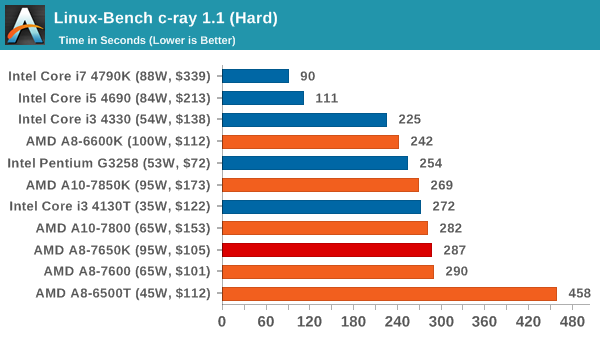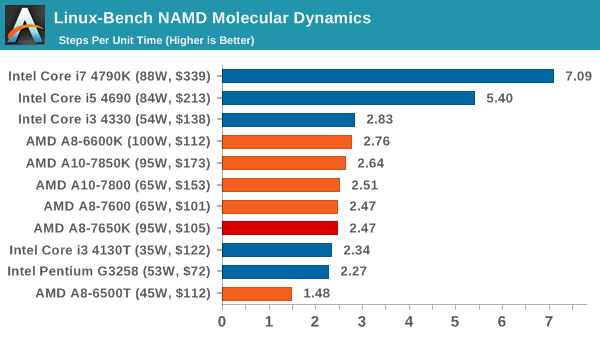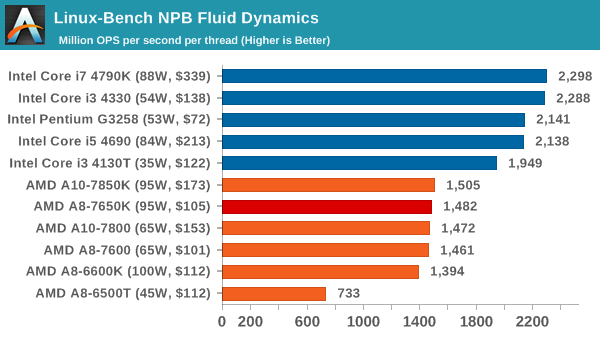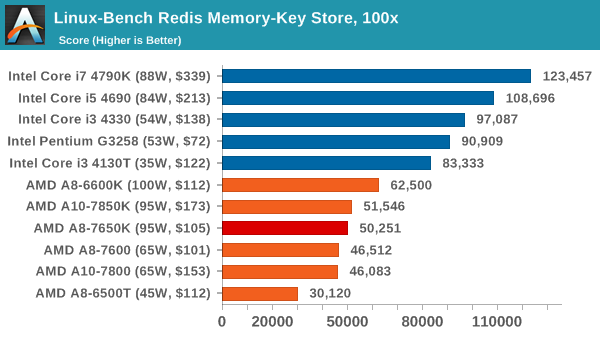The AMD A8-7650K APU Review, Also New Testing Methodology
by Ian Cutress on May 12, 2015 10:00 AM ESTProfessional Performance: Linux
Built around several freely available benchmarks for Linux, Linux-Bench is a project spearheaded by Patrick at ServeTheHome to streamline about a dozen of these tests in a single neat package run via a set of three commands using an Ubuntu 11.04 LiveCD. These tests include fluid dynamics used by NASA, ray-tracing, OpenSSL, molecular modeling, and a scalable data structure server for web deployments. We run Linux-Bench and have chosen to report a select few of the tests that rely on CPU and DRAM speed.
C-Ray: link
C-Ray is a simple ray-tracing program that focuses almost exclusively on processor performance rather than DRAM access. The test in Linux-Bench renders a heavy complex scene offering a large scalable scenario.

Being a scaling benchmark, C-Ray prefers threads and seems more designed for Intel.
NAMD, Scalable Molecular Dynamics: link
Developed by the Theoretical and Computational Biophysics Group at the University of Illinois at Urbana-Champaign, NAMD is a set of parallel molecular dynamics codes for extreme parallelization up to and beyond 200,000 cores. The reference paper detailing NAMD has over 4000 citations, and our testing runs a small simulation where the calculation steps per unit time is the output vector.

NAMD is similar to our office benchmarks, puttin the bulk of the APUs between the i3-4130T and the i3-4330.
NPB, Fluid Dynamics: link
Aside from LINPACK, there are many other ways to benchmark supercomputers in terms of how effective they are for various types of mathematical processes. The NAS Parallel Benchmarks (NPB) are a set of small programs originally designed for NASA to test their supercomputers in terms of fluid dynamics simulations, useful for airflow reactions and design.

Despite the rated memory on the APUs being faster, NPB seems to require more IPC than DRAM speed.
Redis: link
Many of the online applications rely on key-value caches and data structure servers to operate. Redis is an open-source, scalable web technology with a b developer base, but also relies heavily on memory bandwidth as well as CPU performance.











177 Comments
View All Comments
Gigaplex - Tuesday, May 12, 2015 - link
What happened to the DX12 benchmarks? Do we need to remind you that DX12 hasn't even been released yet, so is completely unsuitable for comparing hardware?akamateau - Tuesday, May 12, 2015 - link
Porting a CURRENT game designed and CODED to DX11 MAX SPEC to DX12 does not mean that it will automatically look better or play better if you do not consider faster fps as the main criteria for quality game play. In fact DX11 Game benchmarks will not show ANY increase in performance using Mantle or DX12And logically, continuing to write to this DX11 MAXSPEC will NOT improve gaming community-wide in general. Let’s be clear, a higher spec game will cost more money. So the studio must balance cost and projected sales. So I would expect that incremental increases in game quality may occur over the next few years as studios become more confident with spending more of the gaming budget on a higher MINSPEC DX12 game. Hey, it is ALL ABOUT THE MONEY.
If a game was written with the limitations or, better, say the maximums or MAXSPEC of DX11 then that game will in all likelihood not look any better with DX12. You will run it at faster frame rates but if the polygons, texture details and AI objects aren't there then the game will only be as detailed as the original programming intent will allow.
However, what DX12 will give you is a game that is highly playable with much less expensive hardware.
For instance using 3dMark API Overhead test, it is revealed with DX11 Intel i7-4960 with a GTX 980 can produce 2,000,000 draw calls at 30fps. Switch to DX12 and it is revealed that a single $100 AMD A6-7400 APU can produce 4,400,000 draw calls and get 30 fps. Of course these aren't rendered but you can't render the object if hasn;t been drawn.
If you are happy with the level of performance that $1500 will get you with DX11 then you should be ecstatic to get very close to the same level of play that DX12and a $100 A6 AMD APU will get you!!!!
That was the whole point behind Mantle, er (cough, cough) DX12. Gaming is opened up to more folks without massive amounts of surplus CASH.
silverblue - Tuesday, May 12, 2015 - link
Yes, yes, I see your point about AMD's iGPUs benefitting a lot from DirectX 12/Mantle, however I don't think you needed so many posts to make it. Additionally, not benchmarking a specific way doesn't make somebody a liar, it just means they didn't benchmark a specific way.Draw calls don't necessarily mean better performance, and if you're memory or ROP limited to begin with... what's more, the performance difference between the 384-shader 7600 and the 512-shader 7850K is practically nothing. Based off this, why would I opt for the 7850K when the 7600 performs similarly for less power? The 7400K is only a little behind but is significantly slower in DX11 testing. Does that mean we don't need the 7600 either if we're playing DX12 titles? Has the test highlighted a significant memory bottleneck with the whole Kaveri product stack that DX12 simply cannot solve?
In addition, consider the dGPU results. Intel still smokes AMD on a per-FPU basis. By your own logic, AMD will not gain any ground on Intel at all in this area if we judge performance purely on draw calls.
DirectX 11 is still current. There aren't many Mantle games out there to provide much for this comparison, but I'm sure somebody will have those results on another site for you to make further comparisons.
akamateau - Tuesday, May 12, 2015 - link
There is ONLY ONE BENCHMARK that is relevant to gamers.3dMark API Overhead Test!
If I am considering a GPU purchase I am not buying it becasue I want to Calculate Pi to a BILLION decimal places. I want better gameplay.
When I am trying to decide on an AMD APU or Intel IGP then that decision is NOT based on CineBench but rather what siliocn produces QUALITY GAMEPLAY.
You are DELIBERATELY IGNORING DX12 API Overhead Tests and that makes you a liar.
The 3dMark API Overhead Test measures the draw calls that are produced when the FPS drops below 30. As the following numbers will show the AMD APU will give the BEST GAMING VISUAL EXPERIENCE.
So what happens when this benchmark is run on AMD APU’s and Intel IGP?
AMD A10-7700k
DX11 = 655,000 draw calls.
Mantle = 4,509,000 Draw calls.
DX11 = 4,470,000 draw calls.
AMD A10-7850K
DX11 = 655,000 draw calls
Mantle = 4,700,000 draw calls
DX12 = 4,454,000 draw calls.
AMD A8-7600
DX11 = 629,000 draw calls
Mantle = 4,448,000 draw calls.
DX12 = 4,443,000 draw calls.
AMD A6-7400k
DX11 = 513,000 draw calls
Mantle = 4,047,000 draw calls
DX12 = 4,104,000 draw calls
Intel Core i7-4790
DX11 = 696,000 draw calls.
DX12 = 2,033,000 draw calls
Intel Core i5-4690
DX11 = 671,000 draw calls
DX12 = 1,977,000 draw calls.
Intel Core i3-4360
DX11 = 640,000 draw calls.
DX12 = 1,874,000 draw calls
Intel Core i3-4130T
DX11 = 526,000 draw calls.
DX12 = 1,692,000 draw calls.
Intel Pentium G3258
DX11 = 515,000 draw calls.
DX12 = 1,415,000 draw calls.
These numbers were gathered from AnandTech piece written on March 27, 2015.
Intel IGP is hopelessly outclassed by AMD APU’s using DX12. AMD outperforms Intel by 100%!!!
JumpingJack - Wednesday, May 13, 2015 - link
"There is ONLY ONE BENCHMARK that is relevant to gamers.3dMark API Overhead Test!"
NO, that is a syntethic, it simply states how many draw call can be made. It does not measure the capability of the entire game engine.
There is only ONE benchmark of concern to gamers -- actual performance of the games they play. Period.
Get ready for a major AMD DX12 let down if this is your expectation.
akamateau - Tuesday, May 12, 2015 - link
Legacy Benchmarks?????? i am going to spend money based on OBSOLETE BENCHMARKS???CineBench 11.5 was released in 2010 and is obsolete. It is JUNK
TrueCrypt???? TreuCrypt development was ended in MAY 2014. Another piece of JUNK.
Where is 3dMark API Overhead Test? That is brand new.
Where Is STARSWARM?? That is brand new.
akamateau - Tuesday, May 12, 2015 - link
Where are your DX12 BENCHMARKS?akamateau - Tuesday, May 12, 2015 - link
Where are your DX12 BENCHMARKS?rocky12345 - Tuesday, May 12, 2015 - link
whining about no DX12 test just take the info that was given & learn from that and wait for a released DX12 program that can truely be tested. testing DX12 at this point has very little to offer because it is still a beta product & the code is far from finished & by the time it is done all the tests you are screaming to have done will not be worth a pinch of racoon crap.galta - Tuesday, May 12, 2015 - link
Back when DX11 was about be released, AMD fans said the same: nVidia is better @DX10, but with DX11, Radeons superior I-don't-know-what will rule.Time passed and nVidia smashed Radeons new - and rebranded - GPUs.
I suspect it will be the same this time.